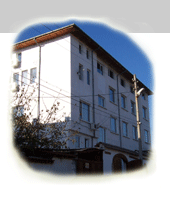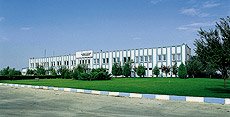Digital Textile Printing Will Increase Its Share More Than Tenfold in Five Years
Digital technology is the fastest growing method of printing textiles, according to a report in the latest issue of Textile Outlook International. Between 2000 and 2005 digitally printed textile output rose by 300% to 70 million square metres.
Although digital methods still account for less than 1% of the global market for printed textiles, their share is likely to expand to as much as 10% by the early part of the next decade.
Screen printing still dominates the textile printing market with 80% of global output. However, this share is expected to fall as digital printing gains more of a foothold in the market.
One reason for the expected growth in digital printing is that more textile manufacturers are able to provide "prepared for print"(PFP) fabrics to digital printers. But much of the increase will be due to improvements in digital printing equipment, such as printheads and ink dispersion techniques. Growth will also stem from advances in pigment-based inks.
New inks for inkjet printing:
Ink producers are offering broader ranges of inkjet inks. Furthermore, many of these inks have some of the favourable properties enjoyed by inks used in conventional textile printing.
For example, DuPont offers the same colorants in its Artistri digital inkjet printer as those which are used in screen printing.
Huntsman has recently launched 11 new inkjet inks under its Terasil DI-HL brand. These have sufficiently high light-fastness to meet standards set by automotive manufacturers for direct inkjet printing on to polyester. The inks are also suitable for applications such as home furnishings, outdoor fabrics and apparel.
Even silk can be printed using inkjet systems, and such techniques are being utilised to print silk for the Italian and other European high fashion sectors. DyStar is marketing inkjet inks for silk based on its Procion and Levafix reactive dyes.
Huntsman has extended its Novacron (formerly Cibacron) range of dyes for inkjet inks. The company claims that these achieve much greater colour intensity than inks based on conventional dyes.
By employing dyes of higher colour strength, printers are able to use lower concentrations of dye to achieve the same depth of colour. This, in turn, results in technical advantages during the printing operation.
Pigment-based inks:
Technological improvements are enabling manufacturers to use pigments rather than dyes when making inks for printing textiles using digital technology. Pigments are intrinsically more light-fast and wash-fast than dyes, and are often less expensive.
Unfortunately, pigmented inks tend to flow less well than dye-based inks. This is important when delivering ink through an inkjet printhead. Fortunately, advances in pigment dispersion techniques and printheads have mitigated this problem.
Furthermore, technological advances in digital printing have led to improvements in the way that pigment-based inks adhere to the surface of the fabric. Pigment particles are coated with advanced surfactants in order to improve dispersion stability. And the same technology is used to help the inks adhere properly to the fabric.
Companies with long-established expertise in pigments -- such as Ciba, BASF, DuPont and Clariant -- have become technological leaders in the development of pigment-based inkjet inks for textiles.
Pigments have a number of advantages over dyes in inkjet printing, and these benefits have contributed to the growth in demand for pigment-based inks.
For example, pigment-based inks can be printed on to a broad variety of fibres and fabrics, whereas dye-based inks are restricted to specific types of fibres and fabrics.
Also, pigment-based inks are more robust than dye-based inks.
Furthermore, pigment-based inks do not need to go through a fixation process using steam to ensure that the ink adheres to the fabric. This makes pigment-based printing more economical in terms of running costs.
Moreover, textiles which have been coloured with pigment-based inks have higher levels of weather fastness and light fastness than those coloured with dye-based inks. Consequently, they are particularly suitable for large fabrics which are printed for outdoor use.
Dye-based inks suffer from a number of disadvantages compared with pigment-based inks. For example, they often contain impurities which can disrupt the sensitive mechanisms of printheads. In this regard, dye-based inks sometimes need to be purified, which can increase operating costs.
Unlike dye-based inks, pigmented inks do not require a solvent to dissolve the colorant. Such solvents are often based on volatile organic compounds which means that dye-based inks tend to be less environmentally friendly than pigmented inks.
Pigment-based inks also offer textile printers the opportunity to employ ultra-violet curing technology during the drying stage. Using this technology, the ink dries almost instantaneously and the fabric can be handled and further processed immediately. Conventional printing processes use heat to dry the ink, which is much slower and less convenient. At present, only around 5% of textile printing employs ultra-violet curing. However this share is expected to exceed 10% within the next five years, according to Textiles Intelligence.
BASF is in the process of upgrading its range of pigment-based inkjet inks. These products are sold under the company's Helizarin label, which is also used for pigment-based concentrates for screen printing.
Helizarin inks contain multi-functional polymeric dispersing agents. These are said to produce prints which are comparable with results obtained using screen printing.
Also, separate binders do not need to be used with Helizarin inks because the binders are already built in. The company claims that the elimination of a separate binder gives printed fabrics a soft handle, high levels of fastness, and good colour strength and brilliance.
Helizarin inks contain pigments in the form of a low viscosity aqueous dispersion which is ideal for inkjet printing.
With the aid of a proprietary pre-treatment process, Helizarin inks can be used on a wide variety of fabrics -- including cotton, polyamide and polyester blends.
The valve-jet process:
Another important development is the use of the valve-jet process to apply the ink to the fibres. This helps to prevent problems encountered in inkjet printing when loose strands of fibres interfere with the flow of ink through the nozzles.
Jets in the printhead are controlled by valves which open and shut independently. Streams of ink droplets are ejected at high velocity and the pressure from the valve is sufficient to ensure that inks penetrate deep into the surface of the fabric.
Austria-based printing machinery manufacturer J Zimmer Maschinenbau has recently launched two new versions of its ChromoJet digital valve-jet textile printer, namely the ChromoJet 400 and the ChromoJet 1200.
These machines are able to print spot colours, process colours and half-tones. Process colour technology prints four colours -- cyan, magenta, yellow and key (black) -- in the form of small dots or half-tones. The colours may overlap, and are able to give a full range of visual effects. The technique is widely used to produce coloured illustrations in magazines and newspapers.
The ChromoJet 400 has valve-jets which can open and close up to 400 times per second, and can print up to 48 colours with a resolution of 1 million pixels per square metre. The machine can be used to print on carpets, rugs, furs and blankets.
The ChromoJet 1200 has valve-jets which are capable of being opened up to 1,200 times per second. It prints to a resolution of 8 million pixels per square metre and it can be used to print on towelling, upholstery, automotive textiles, corduroy and mats.








Hiç yorum yok:
Yorum Gönder